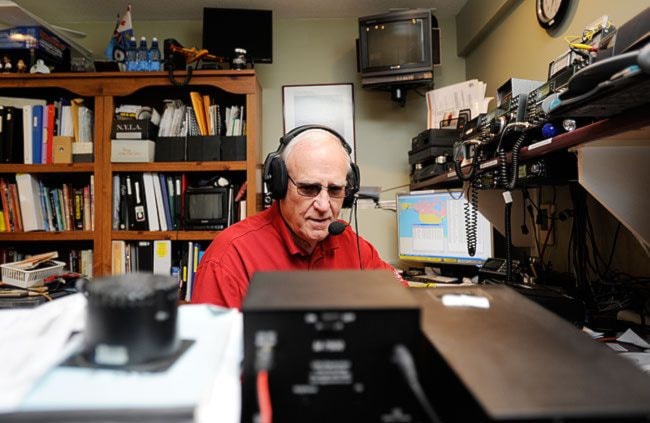When all else fails, ham radio works.
The old saying rang true last month as members of the Yukon Amateur Radio Association helped co-ordinate a search-and-rescue operation north of Whitehorse.
It was the second time since July that ham radio operators demonstrated the usefulness and versatility of the communication system in an emergency situation.
On the evening of Sept. 21, the RCMP called on the Whitehorse search-and-rescue team to assist in locating a missing teenager in the Lake Laberge area.
Terry Hauff, a search-and-rescue veteran with 15 years of experience in the Yukon and the N.W.T., established a command centre on site.
He needed to reach a fellow team member in Whitehorse, who would then mobilize search-and-rescue teams in other communities.
But a faulty satellite phone prevented him from communicating that important information.
“Being a ham radio operator I know that system, I knew I had coverage that far out so it’s the first thing I grabbed,” said Hauff.
“There are other ways I could have done it, but I don’t know how to use the other radios. In time, I could have figured it out, but I had other things to do and needed to be quick.”
Hauff used the radio in his vehicle to touch base with Ron McFadyen, a fellow association member who just happened to be in the basement of his Riverdale home that evening, where his station is set up.
Once contact was established, McFadyen recorded Hauff’s messages and played them back to Whitehorse search-and-rescue member Al Ekholm.
When the teenager was found, Hauff was able to let other teams know they could stand down.
This past July, a late-night car accident near Carmacks kept a woman pinned upside-down in her vehicle for several hours.
Early the next morning, a few transport trucks drove by and the accident was spotted.
A distress call was put out on both CB radio and ham radio frequencies, and a trucker within cell range was able to contact emergency personnel.
McFadyen has been with the association since its inception in 1976 and now serves as vice president.
The association has about 30 paid members but McFadyen estimates there are over 50 ham radio operators in the territory.
The members, classified as professional amateur radio operators, mostly just chat with each other.
But every now and then, operators are called upon to help in emergency situations, like when a NorthwesTel equipment failure in Sept. 2012 caused the loss of 911, landline, cellphone and Internet service across the territory.
The radio association was there to set up an early communication network.
“We provide communication when no one else can,” McFadyen said.
“We’re not in competition with the private industry. We can’t replace the telephone company.
“We’re called upon when other communication systems fail.”
On Sept. 11, 2001, members also pitched in to support the Yukon government’s Health and Social Services Department, as it dealt with passengers from a diverted flight.
The passengers were placed in the Beringia Interpretive Centre while members of the department worked out of the nearby Emergency Measures Organization building.
“There was a lot of congestion with the phones,” McFadyen said, “and we needed to pass information between buildings, which is part of Health.”
“There were a couple hundred people who needed translators, medicine, and other things. It was easier for us to handle over radio.”
In 2004, when wildfires ravaged the territory, operators went down to the Swift River, B.C. area to help firefighters from both jurisdictions communicate with each other.
McFadyen said there are “black holes,” or areas without cell phone coverage, in the territory where ham radios are almost guaranteed to work.
The association owns and operates 22 repeaters, which are interconnected to each other.
Three of them are located on mountaintops above 2,100 metres.
“Our signal starts in Dawson then goes down to Skagway, and all points in between,” McFadyen said.
“We have coverage pretty much the whole way. It’s a very unique system, one of the best amateur radio networks in Canada, given the size of our population.”
The association helps out in other ways, too.
It provides safety communications for the Kluane Chilkat International Bike Relay as well as the Klondike Road Relay.
Contact Myles Dolphin at
myles@yukon-news.com
